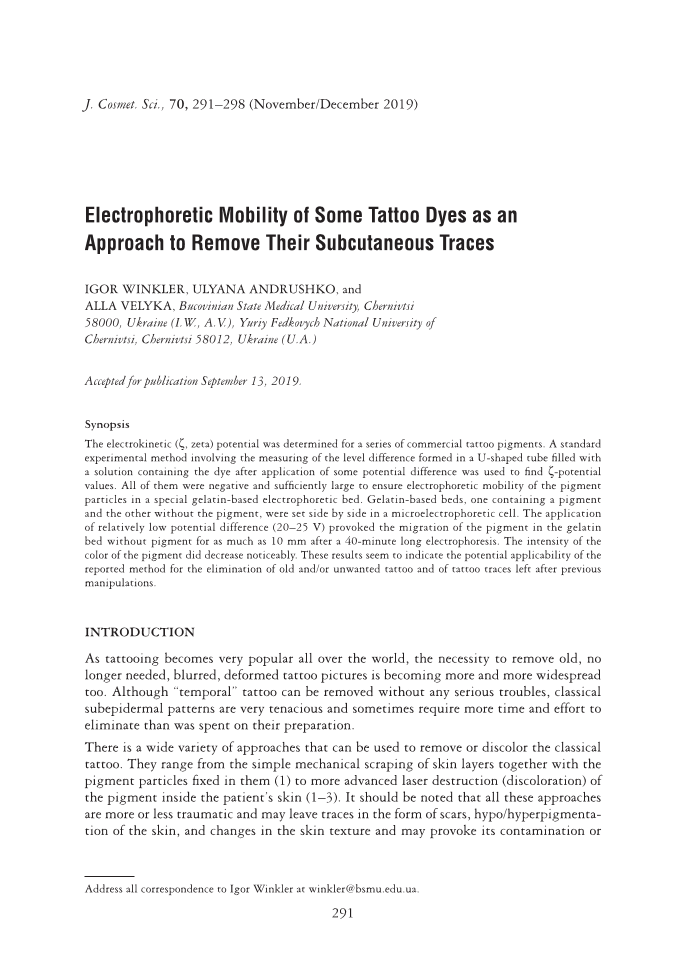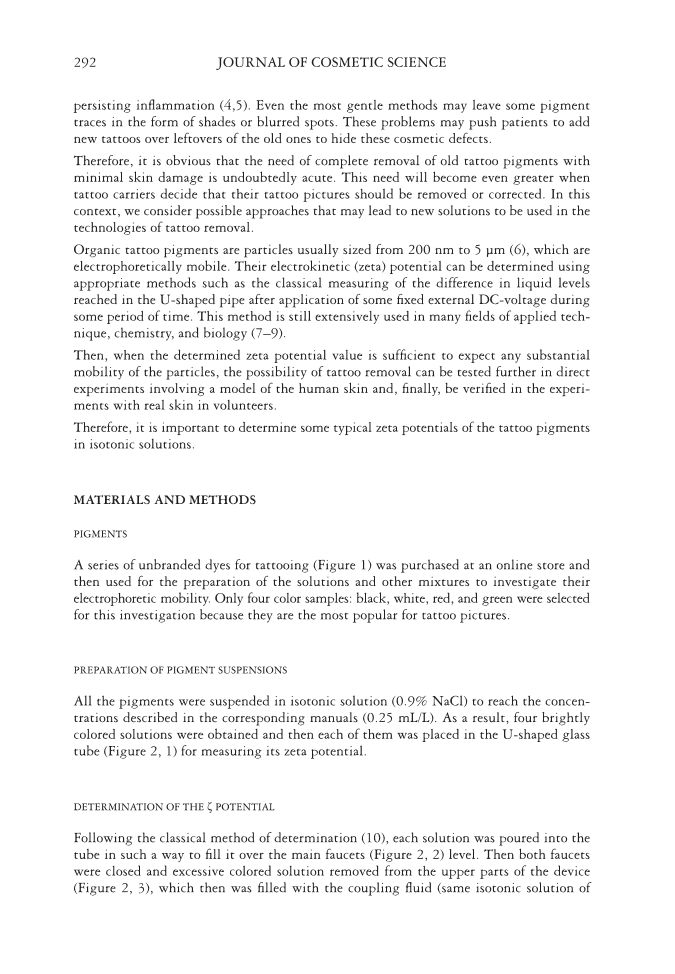J. Cosmet. Sci., 70, 291–298 (November/December 2019) 291 Electrophoretic Mobility of Some Tattoo Dyes as an Approach to Remove Their Subcutaneous Traces IGOR WINKLER, ULYANA ANDRUSHKO, and ALLA VELYKA , Bucovinian State Medical University, Chernivtsi 58000, Ukraine (I.W., A.V.), Yuriy Fedkovych National University of Chernivtsi, Chernivtsi 58012, Ukraine (U.A.) Accepted for publication September 13, 2019 . Synopsis The electrokinetic (ζ, zeta) potential was determined for a series of commercial tattoo pigments. A standard experimental method involving the measuring of the level difference formed in a U-shaped tube fi lled with a solution containing the dye after application of some potential difference was used to fi nd ζ-potential values. All of them were negative and suffi ciently large to ensure electrophoretic mobility of the pigment particles in a special gelatin-based electrophoretic bed. Gelatin-based beds, one containing a pigment and the other without the pigment, were set side by side in a microelectrophoretic cell. The application of relatively low potential difference (20–25 V) provoked the migration of the pigment in the gelatin bed without pigment for as much as 10 mm after a 40-minute long electrophoresis. The intensity of the color of the pigment did decrease noticeably. These results seem to indicate the potential applicability of the reported method for the elimination of old and/or unwanted tattoo and of tattoo traces left after previous manipulations. I N TRODUCTION A s tattooing becomes very popular all over the world, the necessity to remove old, no longer needed, blurred, deformed tattoo pictures is becoming more and more widespread too. Although “temporal” tattoo can be removed without any serious troubles, classical subepidermal patterns are very tenacious and sometimes require more time and effort to eliminate than was spent on their preparation. T here is a wide variety of approaches that can be used to remove or discolor the classical tattoo. They range from the simple mechanical scraping of skin layers together with the pigment particles fi xed in them (1) to more advanced laser destruction (discoloration) of the pigment inside the patient’s skin (1–3). It should be noted that all these approaches are more or less traumatic and may leave traces in the form of scars, hypo/hyperpigmenta- tion of the skin, and changes in the skin texture and may provoke its contamination or Address all correspondence to Igor Winkler at winkler@bsmu.edu.ua.
JOURNAL OF COSMETIC SCIENCE 292 persisting infl ammation (4,5). Even the most gentle methods may leave some pigment traces in the form of shades or blurred spots. These problems may push patients to add new tattoos over leftovers of the old ones to hide these cosmetic defects. T herefore, it is obvious that the need of complete removal of old tattoo pigments with minimal skin damage is undoubtedly acute. This need will become even greater when tattoo carriers decide that their tattoo pictures should be removed or corrected. In this context, we consider possible approaches that may lead to new solutions to be used in the technologies of tattoo removal. O rganic tattoo pigments are particles usually sized from 200 nm to 5 μm (6), which are electrophoretically mobile. Their electrokinetic (zeta) potential can be determined using appropriate methods such as the classical measuring of the difference in liquid levels reached in the U-shaped pipe after application of some fi xed external DC-voltage during some period of time. This method is still extensively used in many fi elds of applied tech- nique, chemistry, and biology (7–9). Th en, when the determined zeta potential value is suffi cient to expect any substantial mobility of the particles, the possibility of tattoo removal can be tested further in direct experiments involving a model of the human skin and, fi nally, be verifi ed in the experi- ments with real skin in volunteers. Th erefore, it is important to determine some typical zeta potentials of the tattoo pigments in isotonic solutions. MA TERIALS AND METHODS PI G MENTS A series of unbranded dyes for tattooing (Figure 1) was purchased at an online store and then used for the preparation of the solutions and other mixtures to investigate their electrophoretic mobility. Only four color samples: black, white, red, and green were selected for this investigation because they are the most popular for tattoo pictures. PR EPARATION OF PIGMENT SUSPENSIONS Al l the pigments were suspended in isotonic solution (0.9% NaCl) to reach the concen- trations described in the corresponding manuals (0.25 mL/L). As a result, four brightly colored solutions were obtained and then each of them was placed in the U-shaped glass tube (Figure 2, 1) for measuring its zeta potential. DE TERMINATION OF THE ζ POTENTIAL Fol lowing the classical method of determination (10), each solution was poured into the tube in such a way to fi ll it over the main faucets (Figure 2, 2) level. Then both faucets were closed and excessive colored solution removed from the upper parts of the device (Figure 2, 3), which then was fi lled with the coupling fl uid (same isotonic solution of
Purchased for the exclusive use of nofirst nolast (unknown) From: SCC Media Library & Resource Center (library.scconline.org)



















































